Papers
-
Turning cycle restrictions into mesh patterns via Foata's fundamental transformation
Submitted
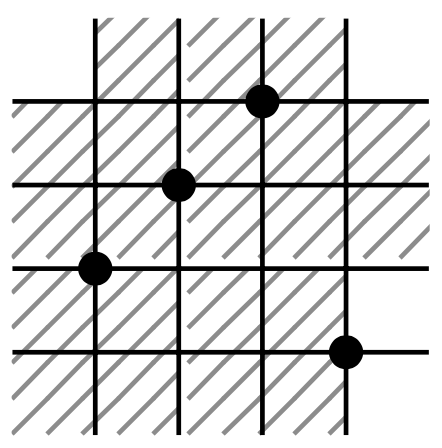 An adjacent q-cycle is a natural generalization of an adjacent
transposition. We show that the number of adjacent q-cycles in a
permutation maps to the sum of occurrences of two mesh patterns under
Foata’s fundamental transformation. As a corollary we resolve
Conjecture 3.14 in the paper ‘‘From Hertzprung’s problem to
pattern-rewriting systems’’ by the first author.
This work was started at Schloss Dagstuhl (Leibniz-Zentrum fur Informatik), seminar 23121, and we thank the institute and the organizers for giving us the opportunity to participate.
An adjacent q-cycle is a natural generalization of an adjacent
transposition. We show that the number of adjacent q-cycles in a
permutation maps to the sum of occurrences of two mesh patterns under
Foata’s fundamental transformation. As a corollary we resolve
Conjecture 3.14 in the paper ‘‘From Hertzprung’s problem to
pattern-rewriting systems’’ by the first author.
This work was started at Schloss Dagstuhl (Leibniz-Zentrum fur Informatik), seminar 23121, and we thank the institute and the organizers for giving us the opportunity to participate.
-
Pattern avoiding Motzkin paths are almost rational
Submitted
 Using a recursive approach, we show that the generating function for sets of Motzkin paths avoiding a single (not necessarily consecutive) pattern is rational over x and the Catalan generating function C(x). Moreover, an algorithm is provided for finding the generating function, also in the more general case of an arbitrary set of patterns. In addition, such an algorithm allows us to find a combinatorial specification for pattern avoiding Motzkin paths, which can be used not only for enumeration, but also for exhaustive and random generation.
Using a recursive approach, we show that the generating function for sets of Motzkin paths avoiding a single (not necessarily consecutive) pattern is rational over x and the Catalan generating function C(x). Moreover, an algorithm is provided for finding the generating function, also in the more general case of an arbitrary set of patterns. In addition, such an algorithm allows us to find a combinatorial specification for pattern avoiding Motzkin paths, which can be used not only for enumeration, but also for exhaustive and random generation.
-
Automated Enumeration of Combinatorial Classes with Proof-Number Search
Submitted 2019
Enumerative combinatorics has traditionally been the domain of work for human mathematicians and has been applied, for instance with the probabilistic method, in computer science. One of the main problems in enumerative combinatorics is the counting of combinatorial classes, and in recent years, efforts have been made to write algorithms to solve such problems. We show that these automated methods may benefit from the application of already mature AI algorithms, such as Proof-Number Search.
-
Enumeration of Permutation Classes and Weighted Labelled Independent Sets
Discrete Mathematics & Theoretical Computer Science, vol. 22 no. 2, Permutation Patterns 2019.
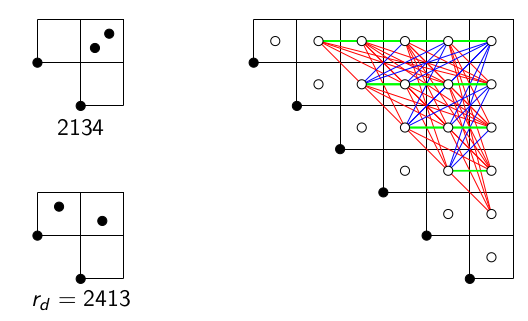 In this paper, we study the staircase encoding of permutations, which maps a
permutation to a staircase grid with cells filled with permutations. We consider
many cases, where restricted to a permutation class, the staircase encoding
becomes a bijection to its image. We describe the image of those restrictions
using independent sets of graphs weighted with permutations. We derive the
generating function for the independent sets and then for their weighted
counterparts. The bijections we establish provide the enumeration of permutation
classes. We use our results to uncover some unbalanced Wilf-equivalences of
permutation classes and outline how to do random sampling in the permutation
classes. In particular, we cover the classes Av(2314,3124) , Av(2413,3142),
Av(2413,3124), Av(2413,2134) and Av(2314,2143), as well as many subclasses.
In this paper, we study the staircase encoding of permutations, which maps a
permutation to a staircase grid with cells filled with permutations. We consider
many cases, where restricted to a permutation class, the staircase encoding
becomes a bijection to its image. We describe the image of those restrictions
using independent sets of graphs weighted with permutations. We derive the
generating function for the independent sets and then for their weighted
counterparts. The bijections we establish provide the enumeration of permutation
classes. We use our results to uncover some unbalanced Wilf-equivalences of
permutation classes and outline how to do random sampling in the permutation
classes. In particular, we cover the classes Av(2314,3124) , Av(2413,3142),
Av(2413,3124), Av(2413,2134) and Av(2314,2143), as well as many subclasses. -
Algorithmic coincidence classification of mesh patterns
Submitted
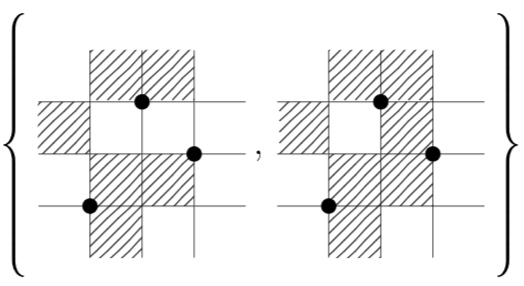 We introduce the concept of a force on a permutation pattern and use it to
strengthen previous results on coincidence classification of mesh patterns. By
creating an algorithm that recursively applies our results we are able to automatically
coincidence classify mesh patterns of length less than 3.
We introduce the concept of a force on a permutation pattern and use it to
strengthen previous results on coincidence classification of mesh patterns. By
creating an algorithm that recursively applies our results we are able to automatically
coincidence classify mesh patterns of length less than 3.
-
Combinatorial Exploration: An Algorithmic Framework for Enumeration
Submitted
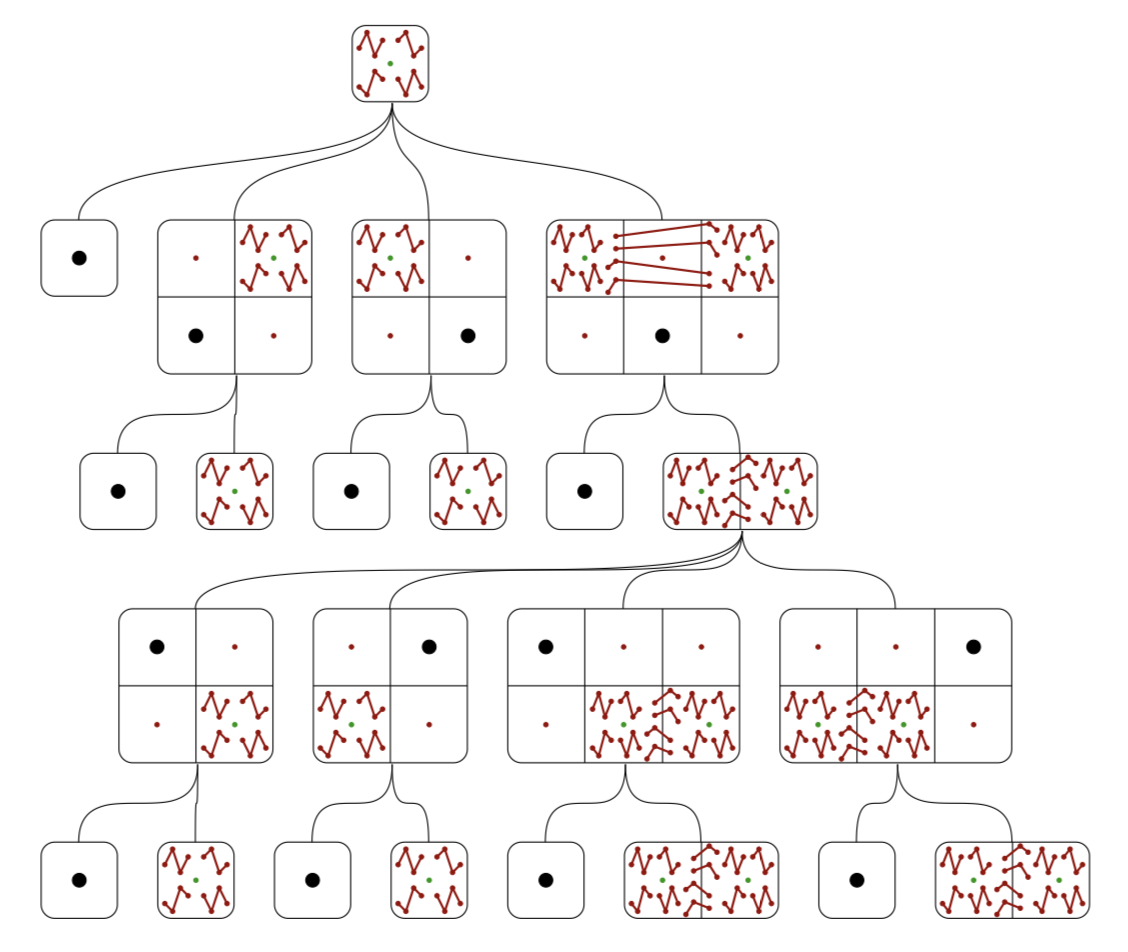 A combinatorial class is often studied by finding a combinatorial specification
for it, which is a description of the class in terms of simpler classes, and
perhaps recursions to smaller instances of the original class.
In this paper we describe how to automate the discovery of combinatorial specifications
of combinatorial classes. This is achieved by first generating a universe of
interconnected combinatorial classes and then searching for a specification
inside this universe. The main application is in the area of permutation
patterns, but other domains such as, set partitions, strings, polyominoes and
lattice paths are discussed considered.
A combinatorial class is often studied by finding a combinatorial specification
for it, which is a description of the class in terms of simpler classes, and
perhaps recursions to smaller instances of the original class.
In this paper we describe how to automate the discovery of combinatorial specifications
of combinatorial classes. This is achieved by first generating a universe of
interconnected combinatorial classes and then searching for a specification
inside this universe. The main application is in the area of permutation
patterns, but other domains such as, set partitions, strings, polyominoes and
lattice paths are discussed considered.
-
The poset of mesh patterns
Discrete Mathematics, Volume 343, Issue 6, June 2020
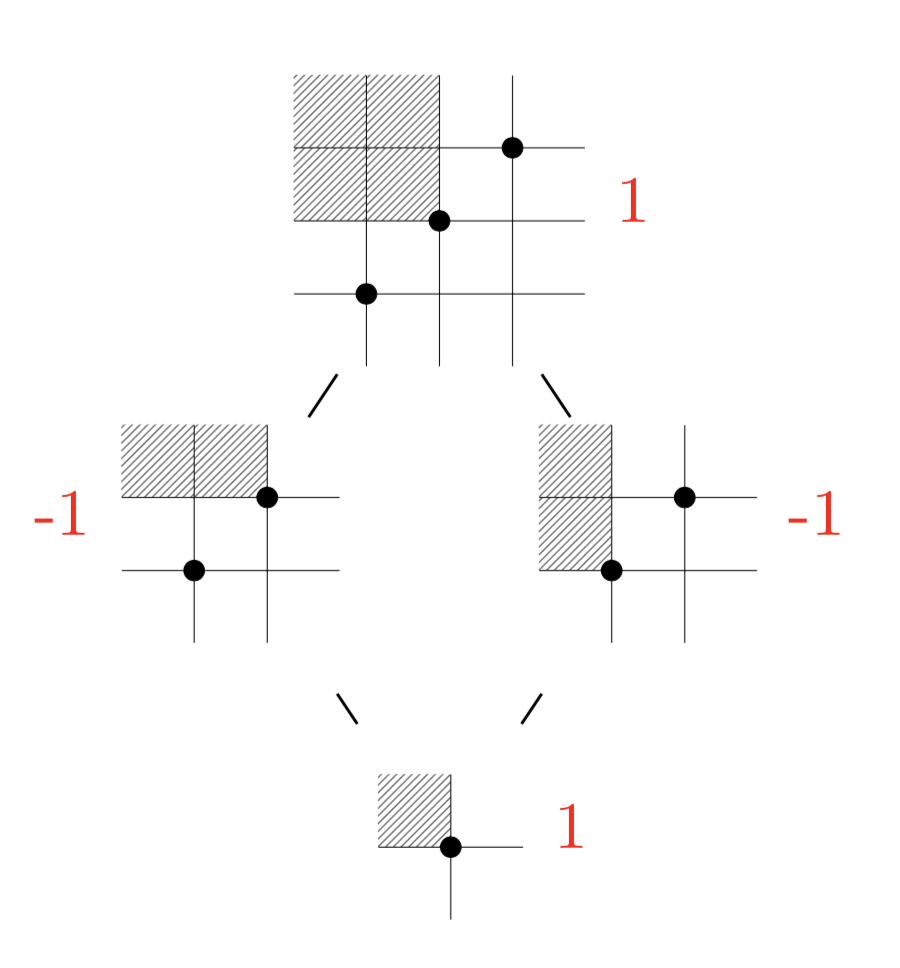 We introduce the poset of mesh patterns, which generalises the permutation
pattern poset. We fully classify the mesh patterns for which the interval [1,m]
is non-pure, where 1 is the unshaded singleton mesh pattern. We present some
results on the Möbius function of the poset, and show that its value on [1,m]
is almost always zero. Finally, we introduce a class of disconnected and
non-shellable intervals by generalising the direct product operation from
permutations to mesh patterns.
We introduce the poset of mesh patterns, which generalises the permutation
pattern poset. We fully classify the mesh patterns for which the interval [1,m]
is non-pure, where 1 is the unshaded singleton mesh pattern. We present some
results on the Möbius function of the poset, and show that its value on [1,m]
is almost always zero. Finally, we introduce a class of disconnected and
non-shellable intervals by generalising the direct product operation from
permutations to mesh patterns.
-
Collatz meets Fibonacci
The MAA Mathematics Magazine, Volume 95, 2022 - Issue 2, p. 130-136
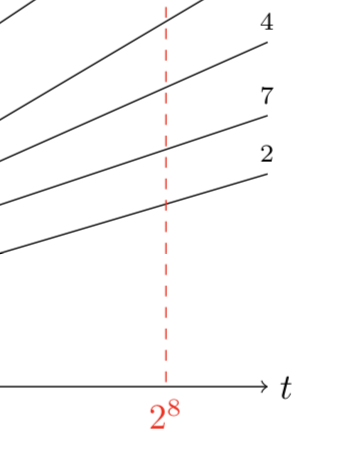 The Collatz map is defined for a positive even integer as half that integer,
and for a positive odd integer as that integer threefold, plus one. The Collatz
conjecture states that when the map is iterated the number one is eventually
reached. We study permutations that arise as sequences from this iteration. We
show that permutations of this type of length up to 14 are enumerated by the
Fibonacci numbers. Beyond that excess permutations appear. We will explain the
appearance of these excess permutations and give an upper bound on the exact
enumeration.
The Collatz map is defined for a positive even integer as half that integer,
and for a positive odd integer as that integer threefold, plus one. The Collatz
conjecture states that when the map is iterated the number one is eventually
reached. We study permutations that arise as sequences from this iteration. We
show that permutations of this type of length up to 14 are enumerated by the
Fibonacci numbers. Beyond that excess permutations appear. We will explain the
appearance of these excess permutations and give an upper bound on the exact
enumeration.
-
BiSC: An algorithm for discovering generalized permutation patterns
In preparation
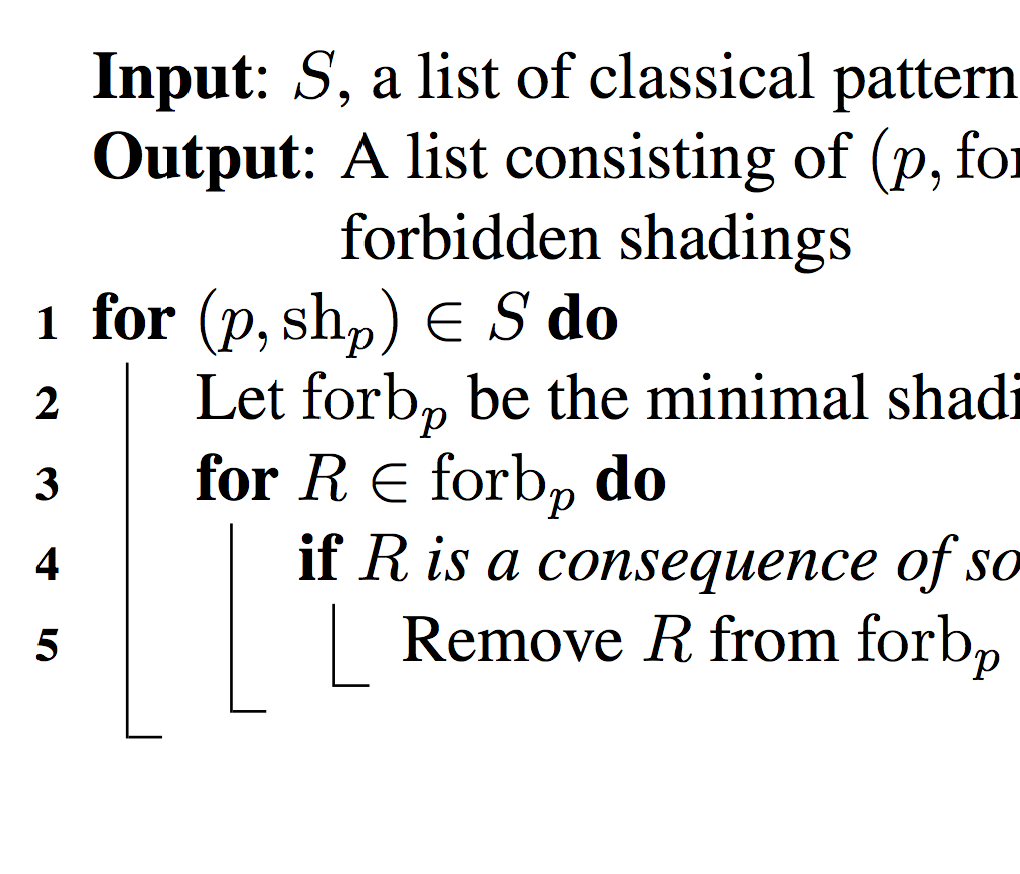 BiSC is an algorithm inspired by a question asked by Sara Billey in the talk
Consequences of the Lakshmibai-Sandhya Theorem
at the AWM Anniversary Conference in 2011. She asked whether one could write an
algorithm for “learning marked mesh patterns”. The BiSC algorithm answers this
question for mesh patterns. The name of the algorithm comes from the last name
of Sara Billey, as well as the last names of Einar Steingrímsson and Anders
Claesson who where also influential in the development of the algorithm.
BiSC is an algorithm inspired by a question asked by Sara Billey in the talk
Consequences of the Lakshmibai-Sandhya Theorem
at the AWM Anniversary Conference in 2011. She asked whether one could write an
algorithm for “learning marked mesh patterns”. The BiSC algorithm answers this
question for mesh patterns. The name of the algorithm comes from the last name
of Sara Billey, as well as the last names of Einar Steingrímsson and Anders
Claesson who where also influential in the development of the algorithm. -
Pattern avoiding permutations and independent sets in graphs
Journal of Combinatorics, Volume 4 (2020), Number 4
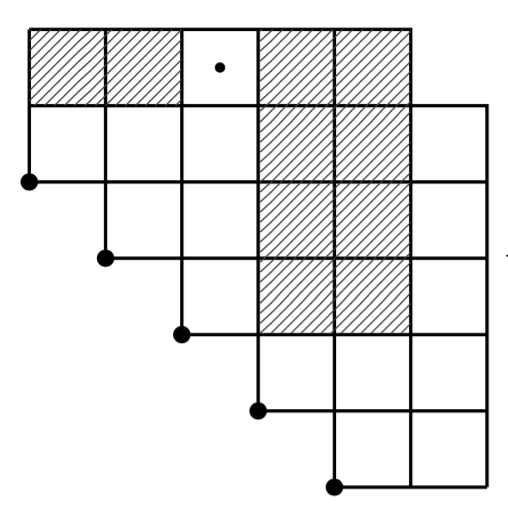 We encode certain pattern avoiding permutations as weighted independent sets in
a family of graphs we call cores. For the classical case of 132-avoiding
permutations we establish a bijection between the vertices of the cores and
edges in a fully connected graph drawn on a convex polygon. We prove that
independent sets in the core correspond to non-crossing subgraphs on the
polygon, and then the well-known enumeration of these subgraphs transfers to an
enumeration of 132-avoiding permutations according to left-to-right minima. We
extend our results to the 123-, (1324, 2143)-, (1234, 1324, 2143)-, (1234,
1324, 1432, 3214)-avoiding permutations. We end by enumerating certain subsets
of 1324-avoiding permutations that satisfy particular conditions on their
left-to-right minima and right-to-left maxima.
We encode certain pattern avoiding permutations as weighted independent sets in
a family of graphs we call cores. For the classical case of 132-avoiding
permutations we establish a bijection between the vertices of the cores and
edges in a fully connected graph drawn on a convex polygon. We prove that
independent sets in the core correspond to non-crossing subgraphs on the
polygon, and then the well-known enumeration of these subgraphs transfers to an
enumeration of 132-avoiding permutations according to left-to-right minima. We
extend our results to the 123-, (1324, 2143)-, (1234, 1324, 2143)-, (1234,
1324, 1432, 3214)-avoiding permutations. We end by enumerating certain subsets
of 1324-avoiding permutations that satisfy particular conditions on their
left-to-right minima and right-to-left maxima. -
Occurrence graphs of patterns in permutations
Involve, Volume 12 (2019), Number 6, 901-918
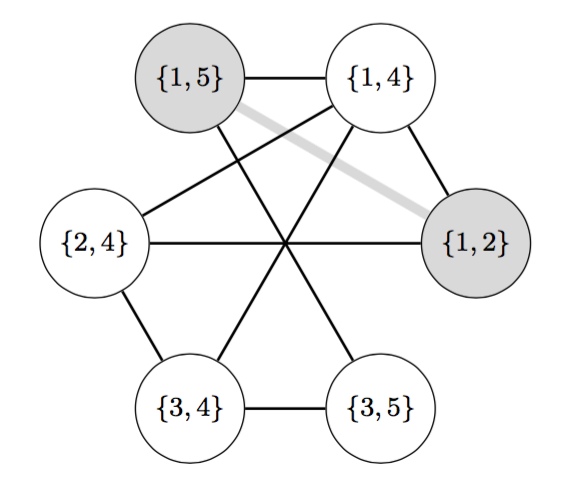 We define the occurrence graph of a pattern p in a permutation as the graph
with the occurrences of p in the permutation as vertices, and edges between the
vertices if the occurrences differ by exactly one element. We then study
properties of these graphs. The main theorem in this paper is that every
hereditary property of graphs gives rise to a permutation class.
We define the occurrence graph of a pattern p in a permutation as the graph
with the occurrences of p in the permutation as vertices, and edges between the
vertices if the occurrences differ by exactly one element. We then study
properties of these graphs. The main theorem in this paper is that every
hereditary property of graphs gives rise to a permutation class. -
Automatic discovery of structural rules of permutation classes
Mathematics of Computation, Volume 88, Number 318, July 2019, Pages 1967–1990
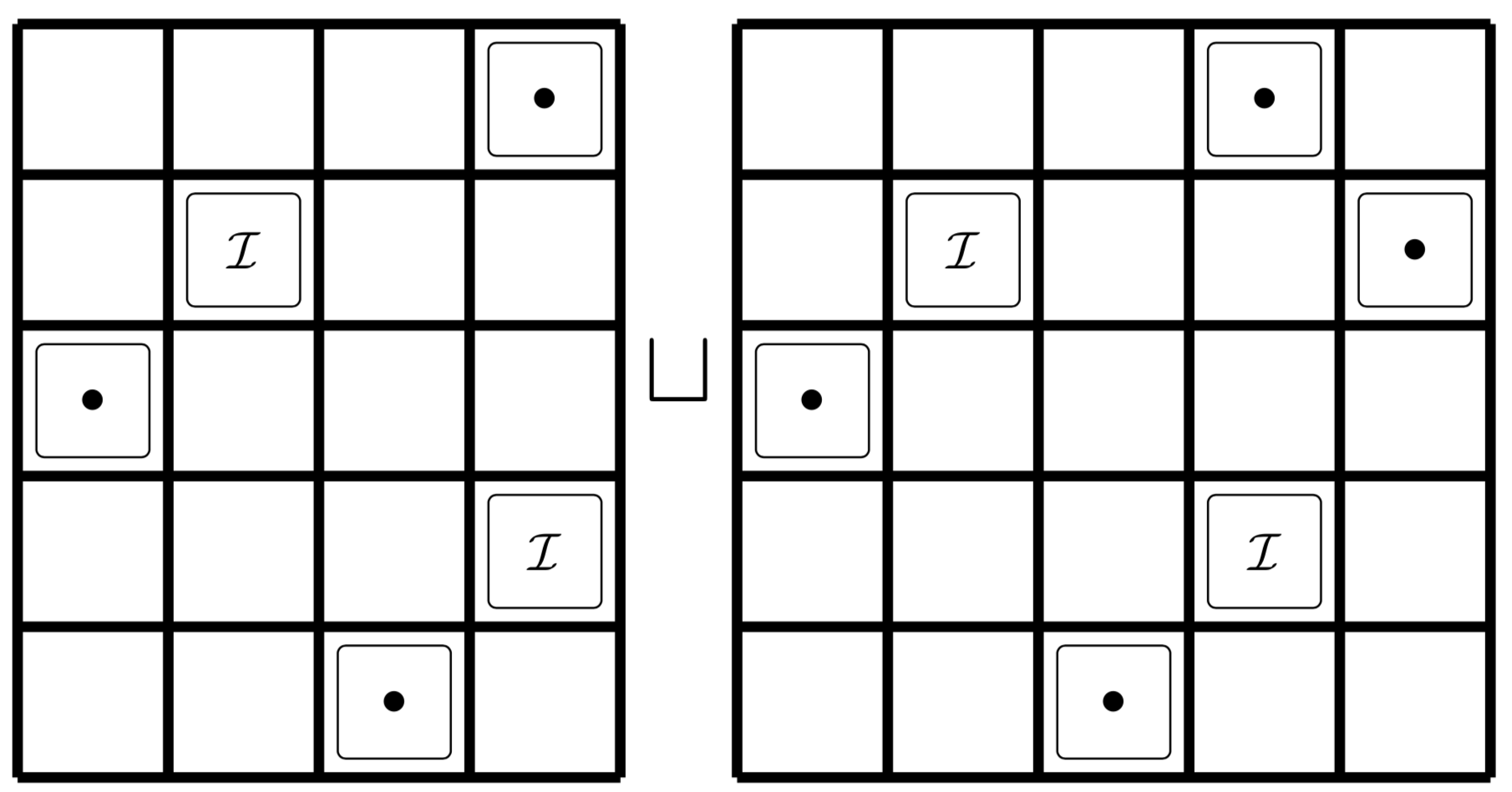 We introduce an algorithm that produces conjectures regarding the structure of
permutation classes. These conjectures take the form of a disjoint cover of
“rules”, each of which is similar to a generalized grid class. Such a cover is
usually easily verified by a human and can often be translated directly into an
enumeration. The algorithm is successful in many cases where other algorithms
fail and is theoretically guaranteed to succeed on any polynomial permutation
class. We apply it to every non-polynomial permutation class avoiding a set of
length four patterns. The structures found by the algorithm sometimes allow
one to enumerate a permutation class with respect to permutation statistics,
and often yield a method for sampling uniformly at random from the class. We
additionally sketch a second algorithm formalizing the human verification of
the conjectured covers.
We introduce an algorithm that produces conjectures regarding the structure of
permutation classes. These conjectures take the form of a disjoint cover of
“rules”, each of which is similar to a generalized grid class. Such a cover is
usually easily verified by a human and can often be translated directly into an
enumeration. The algorithm is successful in many cases where other algorithms
fail and is theoretically guaranteed to succeed on any polynomial permutation
class. We apply it to every non-polynomial permutation class avoiding a set of
length four patterns. The structures found by the algorithm sometimes allow
one to enumerate a permutation class with respect to permutation statistics,
and often yield a method for sampling uniformly at random from the class. We
additionally sketch a second algorithm formalizing the human verification of
the conjectured covers. -
Equivalence classes of mesh patterns with a dominating pattern
Discrete Mathematics & Theoretical Computer Science, February 9, 2018, Vol. 19 no. 2, Permutation Patterns 2016
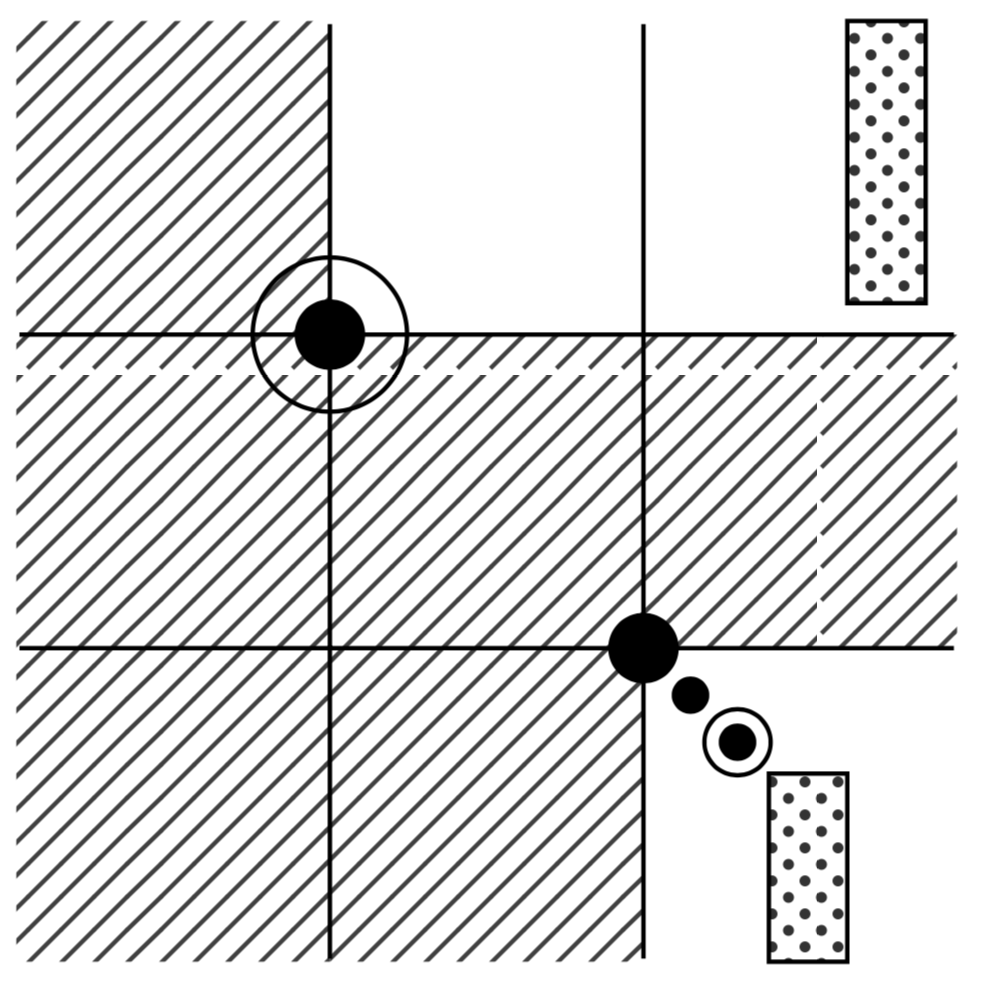 Two mesh patterns are coincident if they are avoided by the same set of
permutations, and are Wilf-equivalent if they have the same number of avoiders
of each length. We provide sufficient conditions for coincidence of mesh
patterns, when only permutations also avoiding a longer classical pattern are
considered. Using these conditions we completely classify coincidences between
families containing a mesh pattern of length 2 and a classical pattern of
length 3. Furthermore, we completely Wilf-classify mesh patterns of length 2
inside the class of 231-avoiding permutations.
Two mesh patterns are coincident if they are avoided by the same set of
permutations, and are Wilf-equivalent if they have the same number of avoiders
of each length. We provide sufficient conditions for coincidence of mesh
patterns, when only permutations also avoiding a longer classical pattern are
considered. Using these conditions we completely classify coincidences between
families containing a mesh pattern of length 2 and a classical pattern of
length 3. Furthermore, we completely Wilf-classify mesh patterns of length 2
inside the class of 231-avoiding permutations.
-
Enumerations of Permutations Simultaneously Avoiding a Vincular and a Covincular Pattern of Length 3
Journal of Integer Sequences, Volume 20 (2017), Article 17.7.6
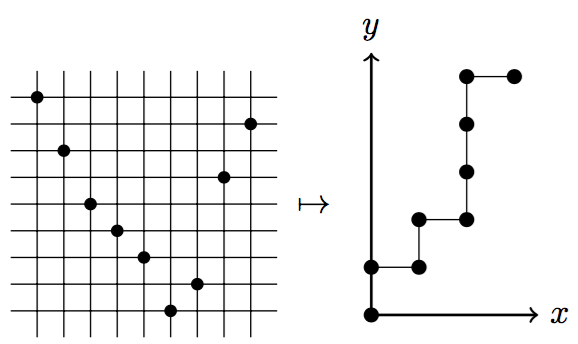 A pattern is said to be covincular if its inverse is vincular. In this paper we
count the number of permutations simultaneously avoiding a vincular and a
covincular pattern, both of length 3. We see familiar sequences, such as the
Catalan and Motzkin numbers, but also some previously unknown sequences which
have close links to other combinatorial objects such as ascent sequences,
lattice paths and integer partitions. Where possible we include a generating
function for the enumeration. We also give an alternative proof of the classic
result that permutations avoiding 123 are counted by the Catalan numbers.
A pattern is said to be covincular if its inverse is vincular. In this paper we
count the number of permutations simultaneously avoiding a vincular and a
covincular pattern, both of length 3. We see familiar sequences, such as the
Catalan and Motzkin numbers, but also some previously unknown sequences which
have close links to other combinatorial objects such as ascent sequences,
lattice paths and integer partitions. Where possible we include a generating
function for the enumeration. We also give an alternative proof of the classic
result that permutations avoiding 123 are counted by the Catalan numbers. -
Sorting and preimages of pattern classes
In preparation
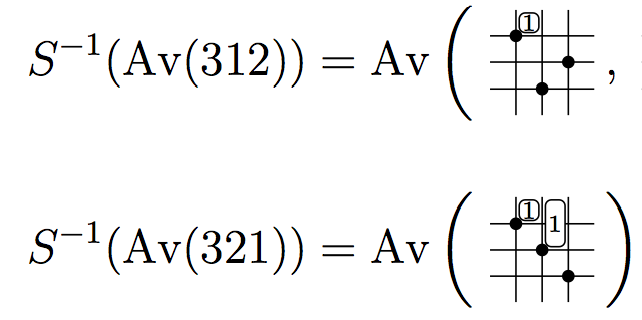 We introduce an algorithm to determine when a sorting operation, such as
stack-sort or bubble-sort, outputs a given pattern. The algorithm provides a
new proof of the description of West-2-stack-sortable permutations, that is
permutations that are completely sorted when passed twice through a stack, in
terms of patterns. We also solve the long-standing problem of describing
West-3-stack-sortable permutations. This requires a new type of generalized
permutation pattern we call a decorated pattern.
We introduce an algorithm to determine when a sorting operation, such as
stack-sort or bubble-sort, outputs a given pattern. The algorithm provides a
new proof of the description of West-2-stack-sortable permutations, that is
permutations that are completely sorted when passed twice through a stack, in
terms of patterns. We also solve the long-standing problem of describing
West-3-stack-sortable permutations. This requires a new type of generalized
permutation pattern we call a decorated pattern. -
Coincidence among families of mesh patterns
The Australasian Journal of Combinatorics 2015, Volume 63 Part 1 (2015)
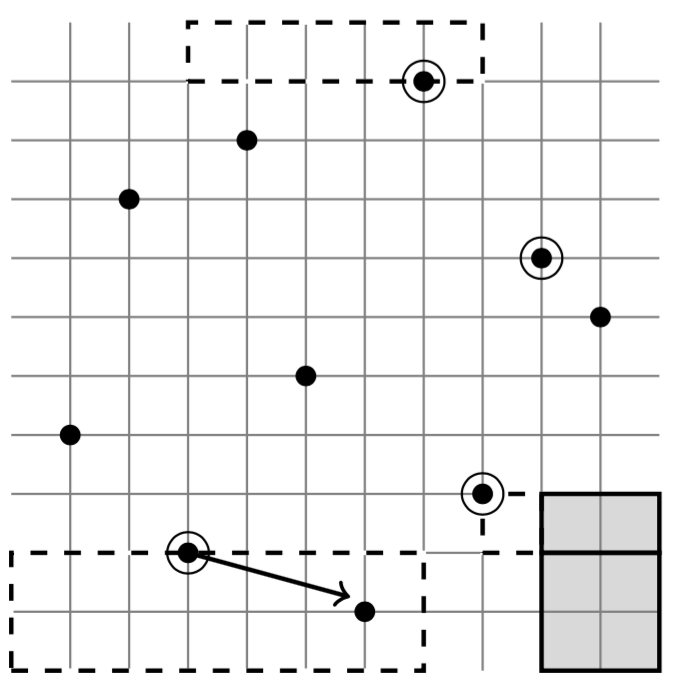 Two mesh patterns are coincident if they are avoided by the same set of
permutations. In this paper, we provide necessary conditions for this
coincidence, which include having the same set of enclosed diagonals. This
condition is sufficient to prove coincidence of vincular patterns, although it
is not enough to guarantee coincidence of bivincular patterns. In addition, we
provide a generalization of the Shading Lemma (Hilmarsson et al.), a result
that examined when a square could be added to the mesh of a pattern.
Two mesh patterns are coincident if they are avoided by the same set of
permutations. In this paper, we provide necessary conditions for this
coincidence, which include having the same set of enclosed diagonals. This
condition is sufficient to prove coincidence of vincular patterns, although it
is not enough to guarantee coincidence of bivincular patterns. In addition, we
provide a generalization of the Shading Lemma (Hilmarsson et al.), a result
that examined when a square could be added to the mesh of a pattern. -
Wilf-classification of mesh patterns of short length
Electronic Journal of Combinatorics, Volume 22 (2015)
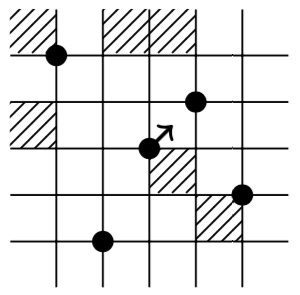 The goal of this paper is to Wilf-classify mesh patterns of length 2. To this
end we prove The Shading Lemma, which gives sufficient conditions for two mesh
patterns to be coincident (i.e., avoided by the same permutations) and
therefore Wilf-equivalent. The lemma, along with other rules which implie
Wilf-coincidence we show that there are at most 56 Wilf-classes of mesh
patterns of length 2. We conjecture that the exact number is 46 and hope to
revisit this area and prove this conjecture.
The goal of this paper is to Wilf-classify mesh patterns of length 2. To this
end we prove The Shading Lemma, which gives sufficient conditions for two mesh
patterns to be coincident (i.e., avoided by the same permutations) and
therefore Wilf-equivalent. The lemma, along with other rules which implie
Wilf-coincidence we show that there are at most 56 Wilf-classes of mesh
patterns of length 2. We conjecture that the exact number is 46 and hope to
revisit this area and prove this conjecture. -
Restricted non-separable planar maps and some pattern avoiding permutations
Discrete Applied Mathematics, Volume 161, Issues 16–17, (2013), Pages 2514-2526
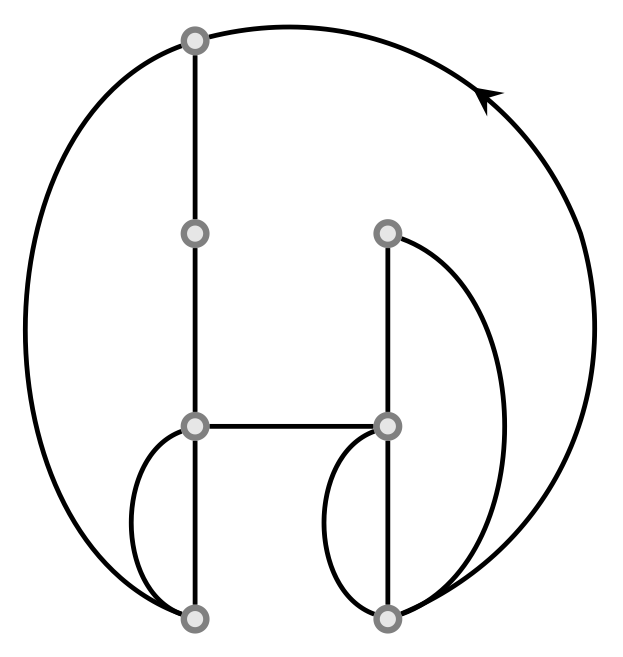 Tutte founded the theory of enumeration of planar maps in a series of papers in
the 1960s. Rooted non-separable planar maps are in bijection with
West-2-stack-sortable permutations, beta(1,0)-trees introduced by Cori,
Jacquard and Schaeffer in 1997, as well as a family of permutations defined by
the avoidance of two four letter patterns. In this paper we give upper and
lower bounds on the number of multiple-edge-free rooted non-separable planar
maps. We also use the bijection between rooted non-separable planar maps and a
certain class of permutations, found by Claesson, Kitaev and Steingrimsson in
2009, to show that the number of 2-faces (excluding the root-face) in a map
equals the number of occurrences of a certain mesh pattern in the permutations.
We further show that this number is also the number of nodes in the
corresponding beta(1,0)-tree that are single children with maximum label.
Finally, we give asymptotics for some of our enumerative results.
Tutte founded the theory of enumeration of planar maps in a series of papers in
the 1960s. Rooted non-separable planar maps are in bijection with
West-2-stack-sortable permutations, beta(1,0)-trees introduced by Cori,
Jacquard and Schaeffer in 1997, as well as a family of permutations defined by
the avoidance of two four letter patterns. In this paper we give upper and
lower bounds on the number of multiple-edge-free rooted non-separable planar
maps. We also use the bijection between rooted non-separable planar maps and a
certain class of permutations, found by Claesson, Kitaev and Steingrimsson in
2009, to show that the number of 2-faces (excluding the root-face) in a map
equals the number of occurrences of a certain mesh pattern in the permutations.
We further show that this number is also the number of nodes in the
corresponding beta(1,0)-tree that are single children with maximum label.
Finally, we give asymptotics for some of our enumerative results. -
Which Schubert varieties are local complete intersections?
Proceedings of the London Mathematical Society, Volume 107, Issue 5 (2013), Pages 1004–1052
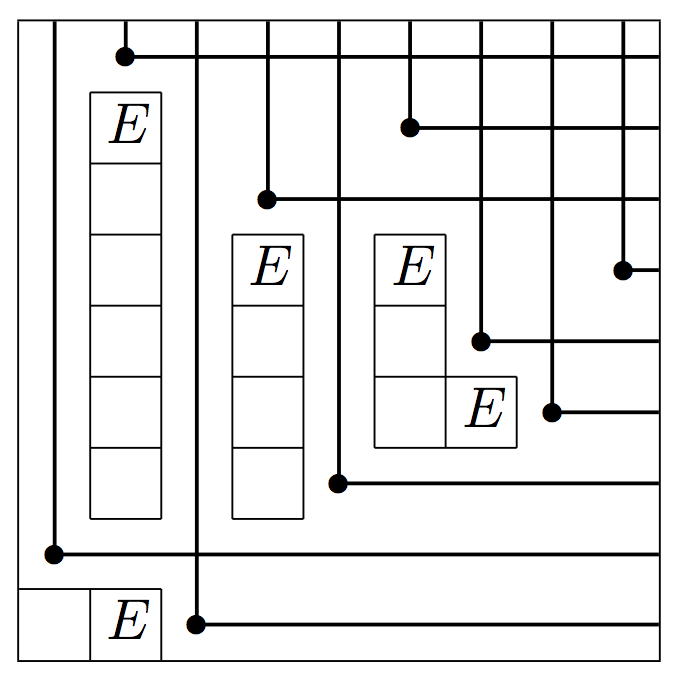 We characterize by pattern avoidance the Schubert varieties for GL_n which are
local complete intersections (lci). For those Schubert varieties which are
local complete intersections, we give an explicit minimal set of equations
cutting out their neighborhoods at the identity. Although the statement of our
characterization only requires ordinary pattern avoidance, showing that the
Schubert varieties not satisfying our conditions are not lci appears to require
working with more general notions of pattern avoidance. The Schubert varieties
defined by inclusions, originally introduced by Gasharov and Reiner, turn out
to be an important subclass, and we further develop some of their
combinatorics. Applications include formulas for Kostant polynomials and
presentations of cohomology rings for lci Schubert varieties.
We characterize by pattern avoidance the Schubert varieties for GL_n which are
local complete intersections (lci). For those Schubert varieties which are
local complete intersections, we give an explicit minimal set of equations
cutting out their neighborhoods at the identity. Although the statement of our
characterization only requires ordinary pattern avoidance, showing that the
Schubert varieties not satisfying our conditions are not lci appears to require
working with more general notions of pattern avoidance. The Schubert varieties
defined by inclusions, originally introduced by Gasharov and Reiner, turn out
to be an important subclass, and we further develop some of their
combinatorics. Applications include formulas for Kostant polynomials and
presentations of cohomology rings for lci Schubert varieties. -
Refined inversion statistics on permutations
Electronic Journal of Combinatorics, Volume 19 (2012)
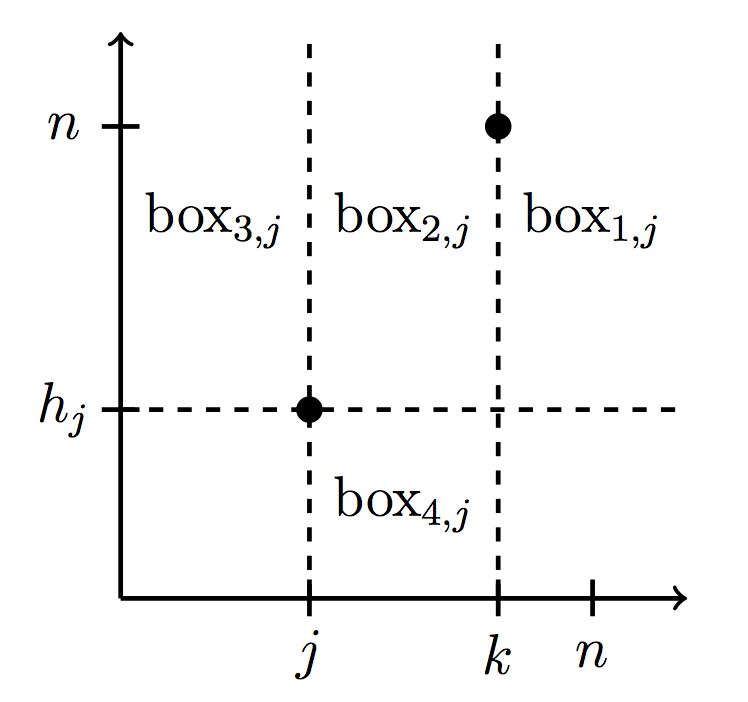 We introduce and study new refinements of inversion statistics for
permutations, such as k-step inversions, (the number of inversions with fixed
position differences) and non-inversion sums (the sum of the differences of
positions of the non-inversions of a permutation). We also provide a
distribution function for non-inversion sums, a distribution function for
k-step inversions that relates to the Eulerian polynomials, and special cases
of distribution functions for other statistics we introduce, such as (\leq
k)-step inversions and (k_1,k_2)-step inversions (that fix the value separation
as well as the position). We connect our refinements to other work, such as
inversion tops that are 0 modulo a fixed integer d, left boundary sums of
paths, and marked meshed patterns. Finally, we use non-inversion sums to show
that for every number n>34, there is a permutation such that the dot product of
that permutation and the identity permutation (of the same length) is n.
We introduce and study new refinements of inversion statistics for
permutations, such as k-step inversions, (the number of inversions with fixed
position differences) and non-inversion sums (the sum of the differences of
positions of the non-inversions of a permutation). We also provide a
distribution function for non-inversion sums, a distribution function for
k-step inversions that relates to the Eulerian polynomials, and special cases
of distribution functions for other statistics we introduce, such as (\leq
k)-step inversions and (k_1,k_2)-step inversions (that fix the value separation
as well as the position). We connect our refinements to other work, such as
inversion tops that are 0 modulo a fixed integer d, left boundary sums of
paths, and marked meshed patterns. Finally, we use non-inversion sums to show
that for every number n>34, there is a permutation such that the dot product of
that permutation and the identity permutation (of the same length) is n. -
Describing West-3-stack-sortable permutations with permutation patterns
Séminaire Lotharingien de Combinatoire, Volume 67 (2012), Article B67d
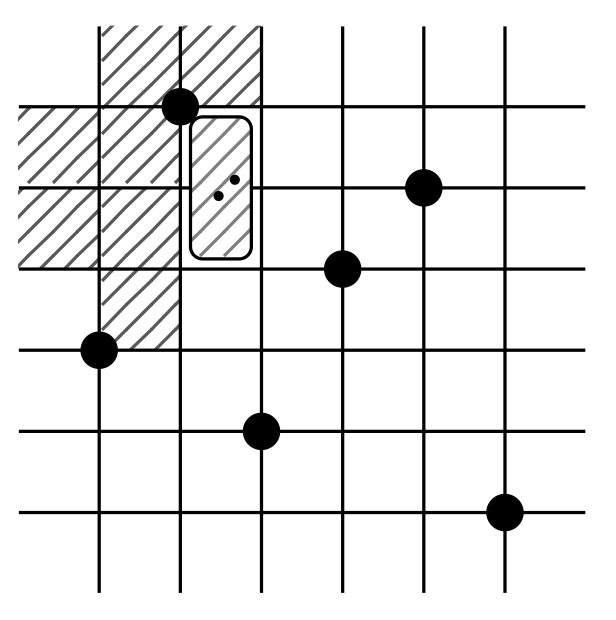 We describe a new method for finding patterns in permutations that produce a
given pattern after the permutation has been passed once through a stack. We
use this method to describe West-3-stack-sortable permutations, that is,
permutations that are sorted by three passes through a stack. We also show how
the method can be applied to the bubble-sort operator. The method requires the
use of mesh patterns, introduced by Branden and Claesson (2011), as well as a
new type of generalized pattern we call a decorated pattern.
We describe a new method for finding patterns in permutations that produce a
given pattern after the permutation has been passed once through a stack. We
use this method to describe West-3-stack-sortable permutations, that is,
permutations that are sorted by three passes through a stack. We also show how
the method can be applied to the bubble-sort operator. The method requires the
use of mesh patterns, introduced by Branden and Claesson (2011), as well as a
new type of generalized pattern we call a decorated pattern. -
Word-representability of line graphs
Open Journal of Discrete Mathematics, Volume 1, Number 2 (2011)
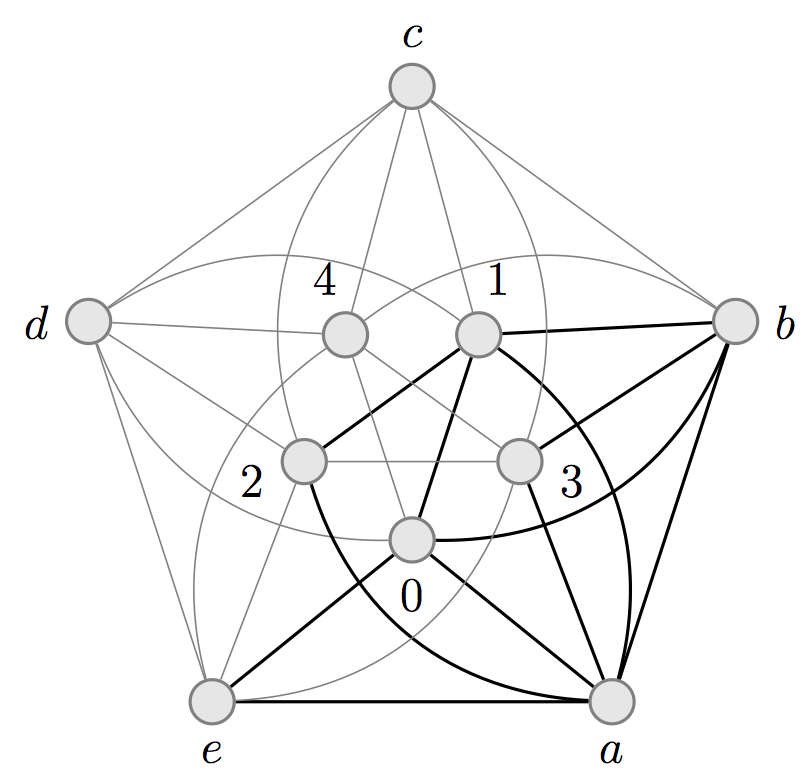 A graph G=(V,E) is representable if there exists a word W over the alphabet V
such that letters x and y alternate in W if and only if (x,y) is in E for each
x not equal to y. The motivation to study representable graphs came from
algebra, but this subject is interesting from graph theoretical, computer
science, and combinatorics on words points of view. In this paper, we prove
that for n greater than 3, the line graph of an n-wheel is non-representable.
This not only provides a new construction of non-representable graphs, but also
answers an open question on representability of the line graph of the 5-wheel,
the minimal non-representable graph. Moreover, we show that for n greater than
4, the line graph of the complete graph is also non-representable. We then use
these facts to prove that given a graph G which is not a cycle, a path or a
claw graph, the graph obtained by taking the line graph of G k-times is
guaranteed to be non-representable for k greater than 3.
A graph G=(V,E) is representable if there exists a word W over the alphabet V
such that letters x and y alternate in W if and only if (x,y) is in E for each
x not equal to y. The motivation to study representable graphs came from
algebra, but this subject is interesting from graph theoretical, computer
science, and combinatorics on words points of view. In this paper, we prove
that for n greater than 3, the line graph of an n-wheel is non-representable.
This not only provides a new construction of non-representable graphs, but also
answers an open question on representability of the line graph of the 5-wheel,
the minimal non-representable graph. Moreover, we show that for n greater than
4, the line graph of the complete graph is also non-representable. We then use
these facts to prove that given a graph G which is not a cycle, a path or a
claw graph, the graph obtained by taking the line graph of G k-times is
guaranteed to be non-representable for k greater than 3. -
A unification of permutation patterns related to Schubert varieties
Pure Mathematics and Applications, Volume 22 (2011), Issue No. 2
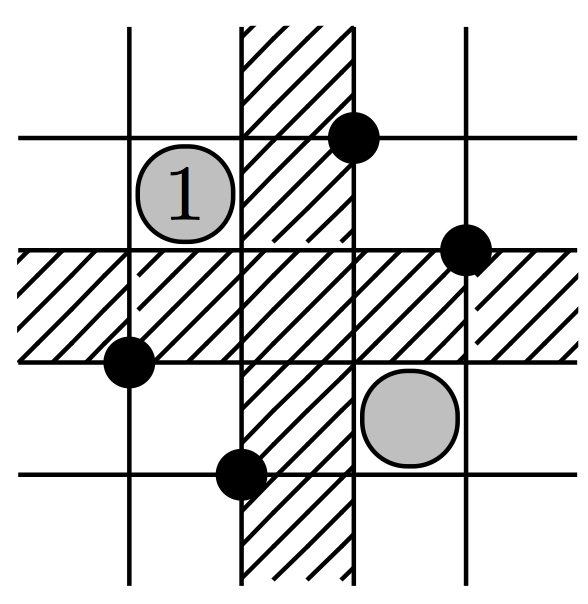 We obtain new connections between permutation patterns and singularities of
Schubert varieties, by giving a new characterization of Gorenstein varieties in
terms of so called bivincular patterns. These are generalizations of classical
patterns where conditions are placed on the location of an occurrence in a
permutation, as well as on the values in the occurrence. This clarifies what
happens when the requirement of smoothness is weakened to factoriality and
further to Gorensteinness, extending work of Bousquet-Melou and Butler (2007),
and Woo and Yong (2006). We also show how mesh patterns, introduced by Branden
and Claesson (2011), subsume many other types of patterns and define an
extension of them called marked mesh patterns. We use these new patterns to
further simplify the description of Gorenstein Schubert varieties and give a
new description of Schubert varieties that are defined by inclusions,
introduced by Gasharov and Reiner (2002). We also give a description of
123-hexagon avoiding permutations, introduced by Billey and Warrington (2001),
Dumont permutations and cycles in terms of marked mesh patterns.
We obtain new connections between permutation patterns and singularities of
Schubert varieties, by giving a new characterization of Gorenstein varieties in
terms of so called bivincular patterns. These are generalizations of classical
patterns where conditions are placed on the location of an occurrence in a
permutation, as well as on the values in the occurrence. This clarifies what
happens when the requirement of smoothness is weakened to factoriality and
further to Gorensteinness, extending work of Bousquet-Melou and Butler (2007),
and Woo and Yong (2006). We also show how mesh patterns, introduced by Branden
and Claesson (2011), subsume many other types of patterns and define an
extension of them called marked mesh patterns. We use these new patterns to
further simplify the description of Gorenstein Schubert varieties and give a
new description of Schubert varieties that are defined by inclusions,
introduced by Gasharov and Reiner (2002). We also give a description of
123-hexagon avoiding permutations, introduced by Billey and Warrington (2001),
Dumont permutations and cycles in terms of marked mesh patterns.